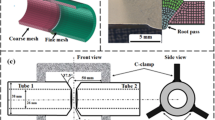Abstract
The simulation of microstructural evolution during the primary breakdown of production-sized alloy 718 ingots and billets by radial forging was accomplished in the laboratory via multiple-stroke axial compression testing of cylindrical specimens. The dwell or hold time between strokes was varied to simulate the deformation-time history for three different locations along the radial-forging work piece: lead-end, mid-length, and tail-end positions. The microstructural evolution varied with simulated work piece position. Static, rather than dynamic, recrystallization was responsible for the observed grain-size refinement, and its repetitive occurrence during consecutive dwell periods resulted in the maintenance of a fine-grain microstructure during multiple-stroke deformation sequences. For comparison, the total plastic strain was also applied in a single-stroke test. The single- and multiple-stroke techniques gave differing microstructural results, indicating that multiple-stroke testing is necessary in modeling microstructural evolution during primary breakdown.
Similar content being viewed by others
References
D.A.K.C. Chang, “The Influence of Ingot Heterogeneity Upon the Hot Deformation of Alloy 718,” M.S. thesis T-3371, Colorado School of Mines, Golden, CO (1987).
M.J. Weis, “The Hot Deformation Behavior of As-Cast Alloy 718,” M.S. thesis T-3382, Colorado School of Mines, Golden, CO (1987).
M.C. Mataya et al., “Grain Refinement during Primary Breakdown of Alloy 718,” 29th Mechanical Working and Steel Processing Conference Proceedings, vol. XXV (Warrendale, PA: ISS, 1987), pp. 235–248.
M.J. Weis et al., “The Hot Deformation Behavior of an As-Cast Alloy 718 Ingot,” Alloy 718—Metallurgy and Applications, ed. E.A. Loria (Warrendale, PA: TMS, 1989), pp. 135–154.
M.C. Mataya and D.K. Matlock, “Effects of Multiple Reductions on Grain Refinement During Hot Working of Alloy 718,” Alloy 718—Metallurgy and Applications, ed. E.A. Loria (Warrendale, PA: TMS, 1989), pp. 155–178.
D.R. Nielsen, “Grain Size Control in Ring-Rolled Alloy 718,” M.S. thesis T-4450, Colorado School of Mines, Golden, CO (1993).
D.R. Nielsen et al., “Grain Size Control in Ring-Rolled 718,” Proceedings of International Symposium on Superalloys 718, 625, 706 and Derivatives, ed. E.A. Loria (Warrendale, PA: TMS, 1994), pp. 373–392.
A.C. Perry, “Hot Deformation Processing and Microstructural Evolution of Alloy 617,” M.S. thesis MT-SRC-095-023, Colorado School of Mines, Golden, CO (1995).
M.C. Mataya and V.E. Sackschewsky, “Effect of Internal Heating during Hot Compression Testing on the Stress-Strain Behavior and Hot Working Characteristics of Alloy 304L,” Metall. Trans. A, 25A (1994), pp. 2737–2752.
M.C. Mataya, E.L. Brown, and M.P. Riendeau, “Effect of Hot Working on Structure and Strength of Type 304L Austenitic Stainless Steel,” Metall. Trans. A, 21A (July 1990), pp. 1969–1987.
M.C. Mataya, M.J. Carr, and G. Krauss, “The Effect of Hot Working on Structure and Strength of a Precipitation Strengthened Austenitic Stainless Steel,” Metall. Trans. A, 15A (February 1984), pp. 347–368.
G. Camus, B. Pieraggi, and F. Chavet, “Hot Deformation and Recrystallization of Inconel 718,” Formability and Metallurgical Structure, eds. A.K. Sachdev and J.D. Embury (Warrendale, PA: TMS, 1986), pp. 305–324.
J.P. Domblesky et al., “Prediction of Grain Size During Multiple Pass Radial Forging of Alloy 718,” Proceedings of International Symposium on Superalloys 718,625, 706 and Various Derivatives, ed. E.A. Loria (Warrendale, PA: TMS, 1994), pp. 263–272.
J.S. Perttula and L.P. Karjalainen, “Recrystallisation Rates in Austenite Measured by Double Compression and Stress Relaxation Methods,” Matls. Sci. and Tech., 14 (July 1998), pp. 2–6.
R. Staker and N.J. Grant, “The Effects of Strain, Strain Rate, and Temperature on Grain Refinement and Hot Workability of Type 305 Stainless Steel,” Mater. Sci. Engr., 75 (1985), pp. 137–150.
W. Roberts, H. Boden, and B. Ahlblom, “Dynamic Recrystallization Kinetics,” Met. Sci., 13 (Mar.–Apr. 1979), pp. 195–205.
A.A. Guimaraes and J.J. Jonas, “Recrystallization and Aging Effects Associated with the High Temperature Deformation of Waspaloy and Inconel 718,” Metall. Trans. A, 12A (September 1981), pp. 1655–1666.
D.K. Matlock and D.A. Burford, “An Experimental Correlation of Plane Strain Deformation Zone Geometry and Forming Loads,” J. Applied Metalworking, 4 (4) (January 1987), pp. 301–305.
D. Zhao et al., “Three-Dimensional Computer Simulation of Alloy 718 Ingot Breakdown by Cogging,” Proceedings of Int’l. Symposium on Superalloys 718,625, 706 and Various Derivatives, ed. E.A. Loria (Warrendale, PA: TMS, 1997), pp. 163–172.
D. Zhao, S. Guillard, and A.T. Male, “High Temperature Deformation Behavior of Cast Alloy 718,” in Ref. 19, pp. 193–204.
R.A. Jaramillo et al., “Evaluation of an Inconel Alloy 718 Microstructural Evolution Model,” in Ref. 19, pp. 257–266.
B. Marty et al., “Recrystallization and Work-Hardening Prediction During Forging Process of Inconel 718,” in Ref. 19, pp. 331–342.
Additional information
Martin C. Mataya earned his Ph.D. in metallurgical engineering at Marquette University in 1974. He is currently a research professor at the Advanced Steel Processing and Products Research Center at the Colorado School of Mines and a staff member in the Materials Science and Technology Division at Los Alamos National Laboratory. Dr. Mataya is a member of TMS.
For more information regarding the Advanced Steel Processing and Products Research Center, contact D. Matlock at (303) 273-3775.
Rights and permissions
About this article
Cite this article
Mataya, M.C. Simulating microstructural evolution during the hot working of alloy 718. JOM 51, 18–26 (1999). https://doi.org/10.1007/s11837-999-0006-x
Issue Date:
DOI: https://doi.org/10.1007/s11837-999-0006-x




